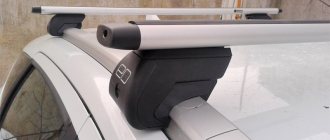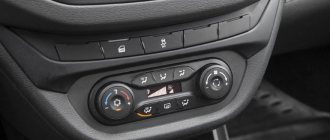Lada Vesta CNG is a modification that allows the use of two types of fuel: compressed natural gas (methane) and gasoline. One of the main advantages of this version is cost-effectiveness. We decided to find out what the real fuel consumption and range of the Lada Vesta with LPG is.
It is worth noting that when using gas, the system still consumes gasoline. This was done to reduce the combustion temperature of the mixture, which reduces the thermal effect on the engine when using gas. According to rough estimates, gasoline consumption is 1-1.5 l/100 km.
Fuel consumption from technical specifications
:
- Urban cycle, l/100 km — 10.1
- Urban cycle, m3/100 km - 8.1
- Extra-urban cycle, l/100 km — 6.0
- Extra-urban cycle, m3/100 km - 5.2
- Combined cycle, l/100 km - 7.5
- Combined cycle, m3/100 km - 6.3
Propane or methane?
There are heated debates on this matter, with the parties giving various arguments. However, in Russia and the CIS countries the vast majority of passenger cars are equipped with propane units.
Methane is a rare type of gas in passenger cars.
Their cylinders are lighter than methane ones, their capacity is larger, and, most importantly, the network of methane filling stations is much less extensive. Even in many large cities there are only a few such gas stations, and in small regional centers, the residents of which Lada Vesta is also aimed at, usually do not have them at all. Consequently, the choice is obvious - all the advantages of methane (cheapness, purity, high octane number, etc.) are largely undermined by the underdeveloped network of gas stations and the significant dimensions and weight of the cylinders. It is not surprising that such gas is usually used in freight transport.
The network of propane gas stations is much wider.
Propane itself is a synthetic gas (liquefied), which is obtained by processing oil, as well as petroleum gases (condensed). Under conditions of low pressure and normal temperature, the fuel is visually a mixture of propane, ethane and butane with an octane rating of 100 units.
Owner reviews
Review #1
:
- average methane consumption is 5.5 cubic meters per 100 km.
- the price of methane is 11-18 rubles per cubic meter.
- 20 cubic meters is enough for 240 km.
Total cost of 1 km is about 1 ruble
Review #2
:
- maximum mileage on a gas cylinder (drove 360 km on the highway in the city 290-300). 1 km - 95 kopecks.
Review #3
:
FOR 3023 km. was spent:
- 21.83 liters of gasoline.
- 242.66 cubic meters of methane.
On average it turns out:
- 242.66/3023*100=8.03 cubic meters per 100 km
- 21.83/3023*100=0.72l per 100km
In terms of money at the moment:
- 8.03*18+0.72*43.89=176r/100km (1.76r/1km)
Review #4
:
About 2 liters of gasoline and 5 cubic meters of methane per 100 km. Total per 100 km: methane - 152 rubles, and gasoline - 294 rubles.
Owner reviews from this article.
Let us remind you that we talked about the real gas consumption of the Lada Vesta earlier. Participate in the survey and leave feedback on methane consumption in the comments.
Keywords: Lada Vesta cng | power supply system for Lada Vesta | Lada Vesta engine
0 0 0 0 0 0
Share on social networks:
Generation choice
At the moment, all gas cylinder installations are divided into 5 generations. Since the Lada Vesta is equipped with simple, in-line power units of atmospheric design, with an injector and distributed fuel injection technology, the fourth generation will be the optimal choice for it.
4th generation HBO scheme.
Earlier generations should not be used, because their technology is currently outdated, and the 5th is intended for turbocharged engines with a direct fuel injection system, which are not available in the Lada Vesta engine line.
5th generation HBO is not suitable for Lada Vesta.
Appearance
Externally, the Lada Vesta in the CNG configuration looks quite attractive, since its design has absorbed many interesting solutions. The front part of the Lada Vesta is made in an X-shaped style, and chrome inserts emphasize this X-shape. Lada Vesta in the CNG configuration is equipped with modern teardrop-shaped optics, which makes the appearance of the car quite aggressive. The X-shaped styling extends to the sides of the car, and this style is emphasized by stamped elements. There is a lot of chrome on the radiator grille, which gives the Lada Vesta a certain charm and sophistication. In the center of the radiator grille there is traditionally the AvtoVAZ emblem, which has increased slightly in size and acquired a new design.
Lada Vesta in CNG configuration is mainly sold in three colors:
- silver;
- black;
- white
But the user can order any color. Two types of rims can be installed on this modification of the car:
- 16 inch;
- 15 inch.
The dimensions of the disks need to be clarified in advance.
IV generation gas equipment - technical features
This generation is distinguished by the fact that gas goes from the gearbox to injectors (gas), which operate on a principle similar to gasoline components. In this case, the injectors are electromagnetic valves. The injectors supply gas, which goes through (calibrated) jets to the area where the Lada Vesta valves (intake) are located.
HBO injectors for Lada Vesta.
The HBO electronics are represented by an electronic control unit, which is similar to a standard automobile controller. It receives data from gasoline injectors, which are processed in the ECU by “gas” software, resulting in the process of recalculating the dosage indicators, but for gas.
Types of control units for gas equipment.
Regarding breakdowns and diagnostics for malfunctions of the gas equipment on the Lada Vesta, such activities should be carried out exclusively with the use of a personal computer and unique software for a specific system.
Refill adapter
Vesta is equipped with gas equipment of the European standard using the NGV1 connector, while in Russia most gas stations have GOST filling fingers installed. Therefore, to refuel with methane you will need a special adapter, which in most cases is called the “NGV1 TO GOST” adapter. You can buy it in various popular online stores, or look for it in stock in your city. The price for it varies greatly - from 4,000 rubles. up to 20,000 rubles, depending on the manufacturer.
The adapter for Vesta itself looks like this:
How to choose and buy the right gas cylinder for Lada Vesta?
Propane cylinders are metal containers for liquefied gas, the operating pressure of which is 16 atmospheres. The wall thickness of such cylinders is 3 mm.
Lada Vesta can be equipped with different types of gas cylinders.
Regarding the types of gas cylinders for Lada Vesta, they differ in shape, and the most common are 2 types:
Cylindrical - the volume of such cylinders varies from 10 to 230 liters, and their diameter (outer) is usually 200, 240, 270, 300, 315, 360, 400 or 450 mm. Passenger cars are usually equipped with cylinders of 40 l, 50 l, 60 l or 90 l. However, the latter are typical for pickups and large SUVs. Regarding the Lada Vesta, it would be most appropriate to install a 40 or 50 liter cylinder. To fix such a cylinder, you will have to prepare special brackets.
Cylindrical propane cylinders.
Torroidal are cylinders made in the shape of a spare wheel, which allows you to place one instead of a spare tire and make it invisible. The most popular cylinders of this type are 40 or 42 liter containers, which corresponds to parameters of 600 by 200 mm. Such dimensions allow the cylinder to be placed in the bulk of the niches for the spare tire. Such containers can be of 3 types:
— external;
— internal;
- vertical.
Toroidal cylinders for Lada Vesta.
In addition, there is a combined type of cylinders, when several containers are connected at once by means of a rigid coupling. However, they are quite rarely used.
A rare version of gas equipment for passenger cars - several cylinders with a rigid coupling.
Data from reviews and test drives
1.
Test drive of the website regnum.ru.
We calculate the benefits over 400 km of travel:
- GAS + gasoline: (20 cubic meters of gas for 12 rubles = 240 rubles) + (6 liters of gasoline for 40 rubles = 240 rubles) = 480 rubles.
- Gasoline: (32 liters of gasoline for 40 rubles = 1280 rubles.
Total: 480/1280 rubles.
2.
Test drive by the Ministry of Energy with the support of AVTOVAZ.
The cost of consumed fuel is 2269 rubles (37 l x 37.70 rubles/l + 53 m3 x 16.5 rubles/m3). Savings when operating a Lada Vesta CNG (compared to a gasoline car) reached 1,124 rubles. or more than 1.6 rub. per 1 km run.
3.
Motor rally "Heart of Russia".
The fuel efficiency of the dual-fuel Lada Vesta is 2.5 times.
4.
Test drive from Anton Avtoman.
Methane consumption - 8.1 Hm3. The price of 1 Hm3 of methane is 13 rubles. The cost of refilling is 105 rubles. Total: the cost of 1 km of run is 0.9 rubles.
Advantages and disadvantages of HBO
This is the most relevant aspect discussed by opponents and supporters of equipping the Lada Vesta with gas equipment.
Advantages of HBO on Lada Vesta
Installation of gas cylinder equipment offers a number of advantages:
— reducing the load on the connecting rod and piston group due to the higher octane number of the gas, as well as indicators of its resistance (anti-knock);
- low cost - mileage costs are reduced by almost half, compared with gasoline;
— purity of propane - this guarantees the absence of carbon deposits on the candles;
— the gas contains no lead, which is found in leaded gasoline;
— softer operation of the motor, provided it is properly adjusted;
— optimization of environmental cleanliness indicators.
When using HBO on the Lada Vesta, you don’t have to worry about carbon deposits on the spark plugs.
However, these are only superficial advantages of HBO, which can be purchased and installed on the Lada Vesta. In addition to them, several more can be distinguished. An important advantage of LPG is the duplication of the power supply system, and this almost completely eliminates stoppages due to interruptions in this complex. Vesta’s range also increases significantly, which is very important for those who make long trips and are not sure of the quality of fuel at provincial gas stations.
Gas stations in the outback of Russia rarely boast of good gasoline.
In addition, installing LPG on new cars, including Lada Vesta, will avoid problems with the catalytic converter and injection system, the repair of which is very expensive. And the depreciation of the gas equipment is small - if we exclude the possibility of injector failure, then timely replacement of rubber components guarantees uninterrupted operation of the gas equipment complex on the Lada Vesta for at least 5 years.
Installation of GO minimizes the likelihood of car failure due to breakdowns in the Lada Vesta injection system.
Some people use gas equipment as a security system - disconnecting the switch blocks the supply of fuel (both gas and gasoline).
Where to refuel?
Now about the sad stuff. There are not many compressed natural gas filling stations in Russia - just over three hundred throughout the country (gasoline - over 25 thousand). But there is some progress: in 2016, 35 such stations were built, and this year it is planned to build twenty-five more.
There are currently four CNG filling stations in Moscow and St. Petersburg. The southern and Caucasian regions are of particular interest; the infrastructure there began to develop earlier - dealers are confident that there will be demand for Vesta CNG.
Disadvantages of installing LPG on Lada Vesta
HBO also has them. The main disadvantage is the deterioration in dynamic characteristics by 5-8%, which is especially important for owners of basic versions of the Lada Vesta, equipped with the weakest, 87-horsepower engine. In addition, the need to constantly transport the spare tire directly in the trunk not only significantly reduces its volume, although Vesta has one of the most spacious, but also significantly affects the ease of use of the luggage compartment space.
Carrying the spare tire directly in the trunk takes away precious usable space.
If the car is under warranty, then installing the LPG yourself will result in loss of the right to warranty repairs. In addition, air filters have to be changed more often, and condensate will need to be drained from the gearbox periodically.
Salon
Lada Vesta CNG is in many ways identical to the Classic, Comfort, Lux, and Standard trim levels. One of the innovations is a pre-installed 12 V socket for passengers in the rear row of seats. The standard place is the front row armrest.
The front seats received a three-level heating system. There is LED lighting along the perimeter of the doorways. Technical characteristics, dimensions, chassis design, fuel type are described in detail in the tabular data at the beginning of the article.
Prejudices of opponents of HBO
They usually relate to 2 points:
- Safety;
- Reliability.
You should not believe theories that the presence of a gas cylinder on board Vesta increases the risk of an explosion. Cylinders, made of almost 4 mm steel, and also equipped with safety valves and other shut-off valves, are much more durable than gas tanks and can withstand very strong impacts in an accident. Moreover, even a break in the fuel lines will not cause detonation. In addition, the ignition temperature of the gas-air mixture of propane is higher than that of gasoline vapor, and the mixture itself is heavier than air.
The strength of HBO cylinders meets the highest standards. They are much stronger than the standard Vesta gas tank.
But there is also an opinion that installing gas equipment will over time negatively affect the condition of Vesta’s fuel system, even to the point of replacing the fuel pump. However, this happens to those drivers who begin to save excessively. After all, the Lada’s power unit starts up on gasoline. Therefore, it is necessary to prevent the gas tank from being completely empty, as this leads to accelerated wear of the gas pump.
With a constant minimum level or absence of gasoline, the Vesta fuel pump wears out faster.
Features of the CNG configuration
The most interesting thing is that the CNG equipment is divided into several more equipment. These are the configurations:
- Start;
- Classic;
- Comfort;
- Lux;
- Multimedia.
These configurations are distinguished from each other by the presence of certain useful options. More expensive trim levels have a larger number of airbags and are equipped with additional head restraints. Top trim levels are equipped with fog lights and a more advanced multimedia system.










